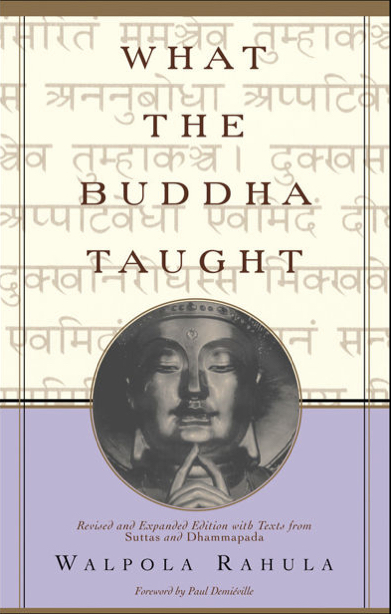What the Buddha Taught Chapter 2. The First Noble Truth Dukkha

Author: Walpola Sri Rahula PUblisher: Newyork, NY: Grove Press. Publish Date: 1959 Review Date: Status:📚
-
Highlight(pink) - Location 529 The fourth is the Aggregate of Mental Formations2 (Saṃkhārak-khandha). In this group are included all volitional activities both good and bad. What is generally known as karma (or kamma) comes under this group.
-
Highlight(pink) - Location 533 Volition is ‘mental construction, mental activity. Its function is to direct the mind in the sphere of good, bad or neutral activities.’4
-
Highlight(pink) - Location 548 It should be clearly understood that consciousness does not recognize an object. It is only a sort of awareness—awareness of the presence of an object. When the eye comes in contact with a colour, for instance blue, visual consciousness arises which simply is awareness of the presence of a colour; but it does not recognize that it is blue. There is no recognition at this stage. It is perception (the third Aggregate discussed above) that recognizes that it is blue.
-
Highlight(pink) - Location 551 The term ‘visual consciousness’ is a philosophical expression denoting the same idea as is conveyed by the ordinary word ‘seeing’. Seeing does not mean recognizing. So are the other forms of consciousness.
-
Highlight(pink) - Location 554 that consciousness (viññāṇa) should not be taken as ‘spirit’ in opposition to matter.
-
Highlight(pink) - Location 555 This point has to be particularly emphasized, because a wrong notion that consciousness is a sort of Self or Soul that continues as a permanent substance through life, has persisted from the earliest time to the present day.
-
Highlight(pink) - Location 557 One of the Buddha’s own disciples, Sāti by name, held that the Master taught: ‘It is the same consciousness that transmigrates and wanders about.’ The Buddha asked him what he meant by ‘consciousness’. Sāti’s reply is classical: ‘It is that which expresses, which feels, which experiences the results of good and bad deeds here and there’.
-
Highlight(pink) - Location 559 ‘To whomever, you stupid one’, remonstrated the Master, ‘have you heard me expounding the doctrine in this manner? Haven’t I in many ways explained consciousness as arising out of conditions: that there is no arising of consciousness without conditions.’ Then the Buddha went on to explain consciousness in detail: ‘Conciousness is named according to whatever condition through which it arises: on account of the eye and visible forms arises a consciousness, and it is called visual consciousness; on account of the ear and sounds arises a consciousness, and it is called auditory consciousness; on account of the nose and odours arises a consciousness, and it is called olfactory consciousness; on account of the tongue and tastes arises a consciousness, and it is called gustatory consciousness; on account of the body and tangible objects arises a consciousness, and it is called tactile consciousness; on account of the mind and mind-objects (ideas and thoughts) arises a consciousness, and it is called mental consciousness.’
-
Highlight(pink) - Location 567 Then the Buddha explained it further by an illustration: A fire is named according to the material on account of which it burns. A fire may burn on account of wood, and it is called wood-fire. It may burn on account of straw, and then it is called straw-fire. So consciousness is named according to the condition through which it arises.1
46
They are all impermanent, all constantly changing. ‘Whatever is impermanent is dukkha’ (Yad aniccaṃ taṃ dukkhaṃ). This is the true meaning of the Buddha’s words: ‘In brief the five Aggregates of Attachment are dukkha.’ They are not the same for two consecutive moments. Here A is not equal to A. They are in a flux of momentary arising and disappearing.
46
‘O Brāhmaṇa, it is just like a mountain river, flowing far and swift, taking everything along with it; there is no moment, no instant, no second when it stops flowing, but it goes on flowing and continuing. So Brāhmaṇa, is human life, like a mountain river.’1 As the Buddha told Raṭṭhapāla: “The world is in continuous flux and is impermanent.’
-
Highlight(pink) - Location 591 One thing disappears, conditioning the appearance of the next in a series of cause and effect. There is no unchanging substance in them. There is nothing behind them that can be called a permanent Self (Ātmari), individuality, or anything that can in reality be called “I”.
-
Highlight(pink) - Location 593 Every one will agree that neither matter, nor sensation, nor perception, nor any one of those mental activities, nor consciousness can really be called ‘I’.2 But when these five physical and mental aggregates which are interdependent are working together in combination as a physio-psychological machine,3 we get the idea of ‘I’. But this is only a false idea, a mental formation, which is nothing but one of those 52 mental formations of the fourth Aggregate which we have just discussed, namely, it is the idea of self (sakkāya-diṭṭhi).
-
Highlight(pink) - Location 598 These five Aggregates together, which we popularly call a ‘being’, are dukkha itself (saṃkhāra-dukkha). There is no other ‘being’ or ‘I’, standing behind these five aggregates, who experiences dukkha. As Buddhaghosa says: ‘Mere suffering exists, but no sufferer is found; The deeds are, but no doer is found.’4 There is no unmoving mover behind the movement. It is only movement.
-
Highlight(pink) - Location 605 Here we cannot fail to notice how this Buddhist view is diametrically opposed to the Cartesian cogito ergo sum: ‘I think, therefore I am.’